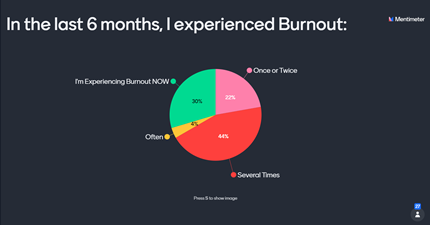|
Burnout? It’s Real – and It’s Wreaking Havoc on Your Assets
Like what is happening with many working people today, I have experienced burnout. But it was years ago when the condition really didn’t have either a name or a proper definition. Today, the World Health Organization defines burnout as a “syndrome conceptualized as resulting from chronic workplace stress that has not been successfully managed”, and they describe three dimensions of employee burnout:
- Feelings of energy depletion or exhaustion
- Increased mental distance from one’s job, or feelings of negativism or cynicism related to one’s job
- Reduced professional efficacy[1]
This past week, during a virtual workshop on burnout, I provided strategies to help identify the symptoms of burnout and design a plan of action to minimize its effects. As part of the webinar, attendees were asked to respond to polling questions, including noting if and when, over the last six months, they had experienced burnout. The results (aggregated below), while not surprising, were quite alarming.

Thirty percent of the participants stated they were experiencing burnout now, while an additional 44% experienced burnout several times during the last six months.
The WHO definition raises a few points to me. The words common to both the definition and the dimensions are manageable, if not controllable. “Chronic.” “Stress.” “Successfully Managed.” “Energy.” “Mental Distance.”
Is burnout a key reason for the Great Resignation? It may be, but burnout is only a symptom of something deeper and even more manageable. Consider how our workplaces have become fast-paced, complex, and demanding. Employees feel overwhelmed by competing demands and conflicting expectations. Finally, technology has blurred – or erased – the lines between home life and work.
Burnout is real and harms every aspect of your life. I know, because I’ve been there. The organization where I worked was ill-equipped to handle the fast-paced, complex, and demanding requirements of a rapidly changing automotive industry. The humans in the equation were not a top priority for the rest of the executive team, and as the leader of the global human resources function, I felt and carried that burden. Between the conflicting projects, impossible deadlines, lack of professional development, and general dysfunction, any efforts to achieve strategic objectives were difficult to manage through. I felt like I worked All.The.Time. To make bad matters worse, there was no remote work option. My commute was 50 miles, each way, which gave me about 2.5 hours of drive time on top of my at-the-office 10-hour workday. You get the picture. The WHO-outlined dimensions were the story of my life.
Next week I’ll tell you a little more of my story, including root causes of my personal burnout and burnout in general. The week after that I’ll share some strategies that leaders can implement to help themselves and their teams fight burnout. Until then, take a moment to consider how burnout is impacting you, your team, your organization, and those you love (outside of work). How are you identifying, engaging with, and addressing burnout in your organization? What can you do differently to lead your team through the challenges of modern-day work?
If you’re seeing, or feeling, burnout, let’s chat. During a 30-minute discussion, we’ll unpack some of your pain points (like not getting the results from your strategy, failing to meet deadlines, discontent within a team, lack of collaboration between or among departments, productivity challenges) and work on a few things you can do immediately to address the pain. The investment is just 30-minutes of your time and a commitment of taking the next step.
Let’s chat.
P.S. Book a Complimentary Strategy Session so we can get you moving in the right direction; click on my Complimentary Strategy Session calendar link here and let’s book a time together so you can get started today!
P.P.S. With over three decades of professional experience in corporate operations and executive human resources, I am a proven results-driven leader. My expertise includes strategy, change management, talent management and organizational development, employee relations, and executive and leadership coaching. I am a highly effective communicator and team leader with demonstrated ability to build long-term relationships across internal and external customer environments built with integrity, confidence, authenticity, and trust.
[1] Burn-out an "occupational phenomenon": International Classification of Diseases (who.int) 2/23/2022
|